June 29, 2021 – Volume 23, Issue 6
In This Issue
- Flanigan’s Eco-Logic: $1 Billion for Distributed Solar in the Developing World
- Recent Episodes of The NetPositive Podcast
- Attacking Maritime Pollution
-
Electric Aviation in the Commuter Segment
-
NATO Goes Green
- Setting Records
-
American Solar Booming!
-
Blowing Up its Last Coal Plant
- Wind Catchers and GOM Wind
- Microgrids 1.7: Interconnection
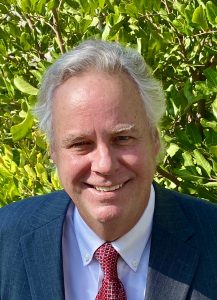
Flanigan’s Eco-Logic: $1 Billion for Distributed Solar in the Developing World
This is exciting news. Yes, the climate is in crisis. Yes, we need governments to step up, as well as others. The IKEA Foundation — the charitable arm of the world’s largest furniture retailer — and The Rockefeller Foundation have partnered and together have pledged a billion dollars to provide solar-powered electricity to a billion people.
This is a big initiative. According to Wood MacKenzie, over the past decade, there has been $2.1 billion in corporate philanthropy and investment in global, off-the-grid access to electricity. That’s about $200 million a year. This new initiative is a billion dollar shot. This new partnership raises the stakes.
Without a solar-powered solution for off-grid and mini-grids, electrification would cause new fossil fuel plant construction and reliance on diesel generators. This new partnership is a carbon-free push to seed distributed clean energy in developing countries. It is to empower 1 billion of the 2.8 billion global citizens without reliable electricity. Fully 800 million lack electricity at all, many in India, Africa, and Latin America, where the two foundations have identified projects. By electrifying with solar, the partnership also intends to cut a billion metric tons of greenhouse gases over the next decade.
All parties understand the challenges that this project inherently faces… including corruption and theft. The program will be “incubated” through RF Catalytic Capital, a public charity created by The Rockefeller Foundation last year. The Rockefeller Foundation has signed commitments for development with The World Bank’s International Finance Corporation and the U.S. International Development Finance Corporation. The hope is that the seed money will help de-risk investment and result in an additional $10 billion from international development organizations.
Hats off to IKEA: In related news, it intends to be climate positive by 2030. In June, it announced a new “Supplier Program” to green its supply chain. It will work to enable its 1,600 suppliers to consume 100% renewable energy. About two-thirds of IKEA’s footprint is related to its supply chain. Through this program, IKEA will support its suppliers by bundling framework agreements and PPAs so suppliers can purchase renewables at the least cost. It will also offer to finance renewable energy generated at suppliers’ on site locations.
Quote of the Week
“After more than 10 years of organizing we have finally defeated an oil giant. Keystone XL is dead! We stood hand-in-hand to protect the next seven generations of life, the water and our communities from this dirty tar sands pipeline.”
Indigenous Environmental Network statement
Recent Episodes of The NetPositive Podcast
 The NetPositive with Kate Unger: Solar Net Energy Metering:
The NetPositive with Kate Unger: Solar Net Energy Metering:
You own a solar system. You are not home. The sun is shining and your solar system is overproducing. That’s good: Your excess power is exported to the grid. At night, your system is not producing at all, so you draw back power from the grid. These exchanges constitute Net Energy Metering (NEM), an arrangement that has made distributed solar financially viable.
NEM is under attack. Utilities claim that it subsidizes the rich who can afford to invest in solar, at the expense of the rest of ratepayers. Why not buy solar in the desert since it is so cheap there? Utilities and some ratepayer advocates are pushing to cut the value of NEM by reducing its export credit value and levying a monthly charge on solar system owners. California’s recent AB 1139 aimed to do just this, and did not get enough votes. It was, however, close and there are strong arguments to be made that, yes, NEM is a subsidy and needs to be changed. “Careful,” says the solar industry. Take away too much and solar will die in the state. Opponents of AB 1139 said that it would extend the payback period for solar on homes to 40 – 50 years. Too long.
Kate Unger is a Senior Policy Director at the California Solar and Storage Association. She is featured on this past week’s episode of The NetPositive Podcast discussing NEM, its value and fate in California.
 The NetPositive with Michael Shepard: Exposure to Cooking Smoke, and a Solution:
The NetPositive with Michael Shepard: Exposure to Cooking Smoke, and a Solution:
Another episode features a conversation with Michael Shepard, a longstanding friend and colleague I worked with many years ago at Rocky Mountain Institute. For many years, Michael headed up E Source, a spinoff of the Institute that has had a global impact.
Now Michael is devoting his time to raising awareness about a huge and largely invisible environmental problem… exposure to cooking smoke. Some 4 billion global citizens rely on primitive, “stone age,” cooking techniques with many health, ecological, and social problems… costing our society trillions of dollars each year.
There is a solution: A model developed in Africa is based on gasification of wood pellets for basic, but clean burning cookstoves. The highly efficient stoves require far less fuel, and hold great promise. Michael is now raising awareness and money to take this problem head on.
Note also that this issue of EcoNet News is also available in audio form. Check out The NetPositive News.
Attacking Maritime Pollution
 The governments of Denmark, Norway, and the United States, along with the Global Maritime Forum and the Maersk McKinney Moller Center for Zero Carbon Shipping, have announced the Zero-Emission Shipping Mission. The initiative aims to accelerate the international public-private collaboration to scale, and to deploy new green maritime solutions. It is intended to set international shipping on an ambitious, zero-emission course. It will also be supported by the governments of India, Morocco, the United Kingdom, Singapore, France, Ghana, and South Korea.
The governments of Denmark, Norway, and the United States, along with the Global Maritime Forum and the Maersk McKinney Moller Center for Zero Carbon Shipping, have announced the Zero-Emission Shipping Mission. The initiative aims to accelerate the international public-private collaboration to scale, and to deploy new green maritime solutions. It is intended to set international shipping on an ambitious, zero-emission course. It will also be supported by the governments of India, Morocco, the United Kingdom, Singapore, France, Ghana, and South Korea.
The Zero-Emission Shipping Mission is part of Mission Innovation, a global initiative of 24 countries and the European Commission. It was launched at COP 21 in Paris 2015 to accelerate clean energy innovation.
Shipping is inherently an efficient mode of transportation. Ships carry 80 – 90% of the global trade, and do so in a less carbon-intensive manner than other freight transport modes such as rail and truck. Nevertheless, international shipping is a significant greenhouse gas emitter. According to the International Maritime Organization, shipping’s GHG footprint is 2.89% of total anthropogenic emissions, ~940 million tons annually. That’s more than all but the top five GHG emitting nations.
The shipping industry seems to have skirted regulation, with the Intergovernmental Panel on Climate Change (IPCC) leaving it to the International Maritime Organization (IMO). Some claim that the IMO has done nothing to advance climate protection. “It’s an industry that burns an oil so thick that it might otherwise be turned into asphalt.” “It’s a big deal,” said one: “Shipping produces as much emissions as all American coal plants combined.”
There are three main goals on the Shipping Mission: First, develop, demonstrate, and deploy zero-emission fuels, ships, and fuel infrastructure; Second, by 2030 have at least 5% of the global deep sea fleet capable of running on green hydrogen, green ammonia, green methanol, and biofuels; Third, by 2030, have at least 200 “well-to-wake” zero-emission fueled ships in service.
Electric Aviation in the Commuter Segment
 The footprint is quite similar to that of shipping, aviation accounted for 2.5% of emissions in 2019. That could triple by 2050 in the absence of innovation. But there is tremendous innovation in aviation, especially with electrification. Reportedly, there are 170 electric airplane projects underway. Airbus plans to have a 100-passenger version ready to fly by 2030.
The footprint is quite similar to that of shipping, aviation accounted for 2.5% of emissions in 2019. That could triple by 2050 in the absence of innovation. But there is tremendous innovation in aviation, especially with electrification. Reportedly, there are 170 electric airplane projects underway. Airbus plans to have a 100-passenger version ready to fly by 2030.
Companies such as Ampaire, MagniX, and Eviation all flight-testing electric aircraft meant for private, corporate, and commuter trips. They are seeking FAA certification. Cape Air plans to buy the Alice 9-passenger electric aircraft from Eviation. It is keen to reap environmental benefits, as well as operational cost savings. Eplanes will only need overhauls every 20,000 hours versus 2,000 hours for conventional planes.
For the foreseeable future, and like cars, electric planes will be limited by range on how far they can travel. The best batteries put out far less energy than conventional fuels, 250 watt hours per kilogram versus 12,000 watt hours per kilogram of jet fuel. That said, about half of all flights in the U.S. are less than 500 miles. That’s expected to be within the range for battery-powered electric aircraft by 2025. This speaks to the rise in short-haul flights.
According to a new study by ICF, while the Boeing 737 isn’t going away anytime soon, electric aviation may redefine the future of short-haul travel in the United States. Smaller Eplanes will likely begin the transition to electrification, for instance serving the nine-seat, short haul, air taxi and commuter market segment.
In the news, and to the contrary, the French government plans to ban air flights for routes that take less than 2.5 hours by train. This policy is intended to shrink the country’s transportation emissions. The Netherlands has been attempting to ban short flights since 2013. Austria has taken action, banning flights that could be accomplished with less than a 3-hour train ride. EuroStar reports that taking the Eurostar train from London to Paris results in a 91% drop in CO2 emissions per passenger compared with plane travel.
NATO Goes Green

Image Courtesy of: Nato/Flickr
The North Atlantic Treaty Organization (NATO) is going green with the intent to be net zero by 2050. Its first step is to study how to do so.
NATO was formed as a bloc to counter the power of the Soviet Union and its satellite states. Members include the US, Canada, Turkey, and most European countries. Now NATO is “Taking on the energy-guzzling machines of modern warfare.” The net zero target will apply to NATO’s operations around the world, mainly in Europe, with some in Turkey, Afghanistan, and the USA.
Military emissions are now on the international agenda, reportedly made possible by the new U.S. administration. Experts note that, “This would have been unthinkable a few months ago.” There are no specific requirements for militaries in The Paris Accord. A Brown University study found that the U.S. military’s fuel use resulted in annual emissions of ~59 million tonnes of CO2e, similar to the country Morocco. Scientists for Global Responsibility found that the European Union’s military carbon footprint is 25 million tonnes; the UK’s is 11 million tonnes.
So what can militaries do to reduce their emissions? They can power their bases and vehicles with renewable energy. They can “re-wild” land that they control. Going green certainly has advantages: less fuel use means less snipers picking off convoys of fuel trucks. In some war-ravaged regions, there has been a human cost for every gallon delivered. Better insulated tents reduce the need for air conditioning, and thus require less fuel for generators. The U.K. is considering running its military aircraft partly on biofuels. President Biden is asking for research on less polluting weapons.
Setting Records
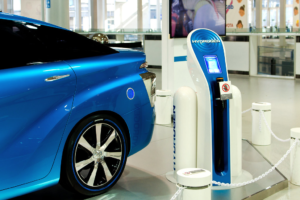 Fuel Cell Vehicles: Toyota Mirai sets the world record range for a hydrogen fuel cell vehicle: 623 miles. Then within five minutes of fueling, it was ready to go another 600+ miles! The Mirai broke the previous fuel cell record by a long shot. It had been held by a Hyundai NEXO which registered 484 miles. Note that last year, the Hyundai Kona set the electric vehicle range record with 630 miles of range on a single charge.
Fuel Cell Vehicles: Toyota Mirai sets the world record range for a hydrogen fuel cell vehicle: 623 miles. Then within five minutes of fueling, it was ready to go another 600+ miles! The Mirai broke the previous fuel cell record by a long shot. It had been held by a Hyundai NEXO which registered 484 miles. Note that last year, the Hyundai Kona set the electric vehicle range record with 630 miles of range on a single charge.
 The Quarter Mile: Tesla Model S Plaid just broke a new production car land speed record. It hit 152 miles per hour in a quarter mile… in just 9.347 seconds at the Famosa Raceway in Bakersfield, California. The previous record was held by a Bugatti Chiron Sport. The Tesla Model S Plaid can go from 1 – 60 in 1.99 seconds, and can reach a top speed of 200 mph.
The Quarter Mile: Tesla Model S Plaid just broke a new production car land speed record. It hit 152 miles per hour in a quarter mile… in just 9.347 seconds at the Famosa Raceway in Bakersfield, California. The previous record was held by a Bugatti Chiron Sport. The Tesla Model S Plaid can go from 1 – 60 in 1.99 seconds, and can reach a top speed of 200 mph.
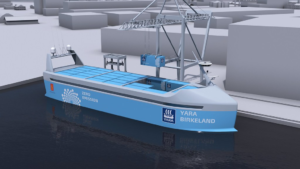 First Autonomous Container Ship: The Yara Birkeland is the world’s first net-zero, battery-powered, autonomous container ship. It was delivered to the Norwegian fertilizer company, Yara Norge AS, in 2020. In 2020, it sailed its maiden voyage, nearly seven hours from Brevik to Horten. It has 7 MWh of batteries on board, the equivalent of ~100 Tesla Model 3s. It’s now undergoing preparations for autonomous operation in late 2021. The use of the container ship will reduce diesel-powered truck transport by 40,000 journeys per year.
First Autonomous Container Ship: The Yara Birkeland is the world’s first net-zero, battery-powered, autonomous container ship. It was delivered to the Norwegian fertilizer company, Yara Norge AS, in 2020. In 2020, it sailed its maiden voyage, nearly seven hours from Brevik to Horten. It has 7 MWh of batteries on board, the equivalent of ~100 Tesla Model 3s. It’s now undergoing preparations for autonomous operation in late 2021. The use of the container ship will reduce diesel-powered truck transport by 40,000 journeys per year.
 The Steinway Tower: At 1,428 feet tall and only 60 feet wide, it is the world’s skinniest skyscraper (width-to-height ratio). It will be 82 floors tall with a single apartment on each floor. Located at 111 West 57th Street, it’s nearly complete. The first five floors will contain shared recreation spaces and high-end retail, while the upper 77 floors will house luxury apartments, the highest cost of which lists for $100 million. The project is being built in the courtyard of the historic Steinway Hall, a 96-year old building that housed a concert hall and piano showrooms for Steinway and Sons. Steinway Hall was sold to developers of 111 West 57th in 2013 and is being refurbished for classic residences. The developers acquired the landmark building and adjacent lot to build the skyscraper.
The Steinway Tower: At 1,428 feet tall and only 60 feet wide, it is the world’s skinniest skyscraper (width-to-height ratio). It will be 82 floors tall with a single apartment on each floor. Located at 111 West 57th Street, it’s nearly complete. The first five floors will contain shared recreation spaces and high-end retail, while the upper 77 floors will house luxury apartments, the highest cost of which lists for $100 million. The project is being built in the courtyard of the historic Steinway Hall, a 96-year old building that housed a concert hall and piano showrooms for Steinway and Sons. Steinway Hall was sold to developers of 111 West 57th in 2013 and is being refurbished for classic residences. The developers acquired the landmark building and adjacent lot to build the skyscraper.
American Solar Booming!
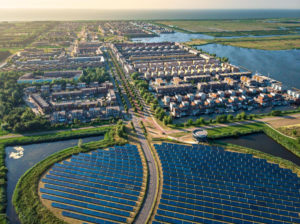 The U.S. solar market surpassed 100 GW of capacity a few months ago, doubling the size of the U.S. industry in 3.5 years. It was a record-setting quarter; solar represented 58% of all new generating capacity in the United States. Think of a gigawatt as a nuclear reactor! Naturally the sun only shines part of the time, so 1 GW of solar produces 20-25% of that of a reactor that operates continuously. There was 5 GW of electric capacity installed in the United States in the quarter, dominated by 3.6 GW of utility-scale solar.
The U.S. solar market surpassed 100 GW of capacity a few months ago, doubling the size of the U.S. industry in 3.5 years. It was a record-setting quarter; solar represented 58% of all new generating capacity in the United States. Think of a gigawatt as a nuclear reactor! Naturally the sun only shines part of the time, so 1 GW of solar produces 20-25% of that of a reactor that operates continuously. There was 5 GW of electric capacity installed in the United States in the quarter, dominated by 3.6 GW of utility-scale solar.
Texas led all states in terms of new solar capacity installed according to the U.S. Solar Market Insight Q2 2021 report, released by the Solar Energy Industries Association and Wood Mackenzie. It forecasts that another 160 GW of capacity will be installed by 2026 despite recent solar supply-chain disruptions. Key inputs for solar modules and installations, including polysilicon, steel, aluminum, semiconductor chips, copper and other metals, are facing supply constraints.
Blowing Up its Last Coal Plant
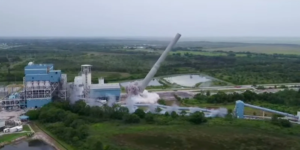 On June 17th, Florida Power and Light blew up its last coal-fired power plant, the Indiantown Cogeneration Plant in Martin County, just east of the Everglades. The blast toppled the plant’s 495-chimney; its 800-foot coal chute collapsed. Going clean and green, FPL’s CEO announced that the utility has built more than 41 solar energy centers in the state with nearly 3,000 MW of capacity. FPL is well on its way to installing 30 million solar panels by 2030, it’s 30:30 Plan. Near the retired coal plant, FPL will be breaking ground on a 75 MW solar plant.
On June 17th, Florida Power and Light blew up its last coal-fired power plant, the Indiantown Cogeneration Plant in Martin County, just east of the Everglades. The blast toppled the plant’s 495-chimney; its 800-foot coal chute collapsed. Going clean and green, FPL’s CEO announced that the utility has built more than 41 solar energy centers in the state with nearly 3,000 MW of capacity. FPL is well on its way to installing 30 million solar panels by 2030, it’s 30:30 Plan. Near the retired coal plant, FPL will be breaking ground on a 75 MW solar plant.
FPL is on a green roll. It is also constructing what it claims will be the world’s largest solar-powered battery facility. By 2030, FPL says it will install an additional 700 MW of battery storage. FPL also offers the FPLSolarTogether program, the largest community solar program in the United States. Electrek points out, however, that the company isn’t “gung-ho about all solar.” As is the case in California, FPL and other Florida utilities are trying to roll back net energy metering. Its critics claim that FPL is only in favor of solar that it can sell.
Wind Catchers and GOM Wind
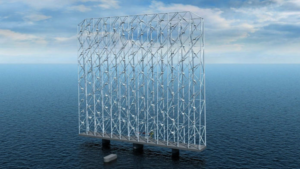
Image Courtesy of: Wind Catching Systems
Arrays of mini-turbines can generate five times more power than a single wind turbine in the same area. Will a new form of offshore wind grow… in the form of wind catchers? Norwegian startup company called Wind Catching Systems (WCS) envisions dozens of 1 MW wind turbines assembled in large sails that will float on the surface of the ocean. They will be affixed to the seabed using turret mooring, a system used by oil and gas rigs. A scaled-down version of the wind catcher system will be tested in a wind tunnel in Milan, Italy.
Floating wind farms are planned for the United States, France, Portugal, and Norway. The only operating floating wind farm is Hywind Scotland. Its five turbines have been running for three years. The floating technology opens up new avenues: Floating farms can be located further offshore where winds are stronger and more consistent.
Gulf Wind: In other wind news, the Gulf of Mexico (GOM) is now being considered for offshore wind. The Department of the Interior’s Bureau of Ocean Management has published a Request for Interest in offshore wind development in the outer continental shelf, targeting the coasts of Louisiana, Texas, Mississippi, and Alabama.
Speaking to the investigation of renewable development in the Gulf, Secretary Deb Haaland noted that, “This is an important first step to see what role the Gulf may play in this exciting frontier.” The GOM is a major hub for oil and gas production. A recent pause on federal auctions has raised industry objections. Renewables may transform development there.
A study by the National Renewable Energy Laboratory found that the Gulf’s shallow waters and close proximity to oil and gas infrastructure would support offshore wind development. Lower wind speeds, soft soils, and hurricanes were cited as challenges.
Microgrids 1.7: Interconnection
 This chapter in the 10-part series on microgrids focuses on interconnecting microgrids with electric utilities. Microgrids have many virtues for their users and their host utilities, but in California, it’s been challenging getting them interconnected to the utility grid. It’s complex and technical stuff, so we’ll work to keep it simple. EcoMotion was in touch with three leading microgrid developers — MBL Energy, Engie, and Schneider Electric — and met with their super-knowledgeable engineers to discuss their interconnection experiences in California.
This chapter in the 10-part series on microgrids focuses on interconnecting microgrids with electric utilities. Microgrids have many virtues for their users and their host utilities, but in California, it’s been challenging getting them interconnected to the utility grid. It’s complex and technical stuff, so we’ll work to keep it simple. EcoMotion was in touch with three leading microgrid developers — MBL Energy, Engie, and Schneider Electric — and met with their super-knowledgeable engineers to discuss their interconnection experiences in California.
Kirk Stokes is the head of energy storage solutions for MBL Energy. He put microgrid interconnection in a seasoned and useful perspective in our conversation in the recent episode of The NetPositive Podcast. “Some context,” advises Kirk. He explains that it’s taken a couple decades, but now utilities are comfortable hooking up net energy metered solar systems. Utilities wanted to make sure that systems automatically shut down during an outage so that linemen are not in danger of power back-feeding. Thanks to clear protocols, and years of familiarity, there are now expedited permitting processes for solar.
Unlike solar systems that operate daily and are then disconnected if the grid goes down, emergency generators sit idle and power up when the grid goes down. This might seem threatening for the same reason: back-feeding. But utilities have been comfortable with generators for years. Generators have been successfully operating for decades, controlled by Automatic Transfer Switches (ATS) that shut off utility service and replace it with generator service.
Now, says Kirk, we add a new wrinkle: Instead of solely operating during normal grid-tied operations as solar + storage do, or during outages as generators do, microgrids operate in both grid-tied and outage modes. To a utility planner, they look like small generating plants, and that raises concerns, largely the same concerns about back-feeding into the utility grid. So how can utility concerns be addressed and allayed?
For EcoMotion’s Santa Rita project, interconnection was delayed by engineering reviews, the requirement that a specific relay was installed for the six microgrids there, as well as third party engineering reviews. Relays are electrically operated switches that open and close circuits by receiving electrical signals from outside sources. Given the utility requirements, at a minimum, the process to gain permission to operate takes a year. That’s frustrating and costly. Instead of relays, Kirk recommends designing systems that employ Automatic Transfer Switches that are trusted by utilities, specifically UL-approved Automatic Transfer Switches to shorten the process while achieving the same safety result.
Our colleagues at Engie report on challenges with interconnection. Engie is developing microgrids throughout California. Our colleagues report that, yes, utilities are getting more familiar with these projects, but the approval process can be tough sledding. Engie often successfully uses a Schweitzer Engineering Laboratories SEL 700 G Relay to control the breaker that will island the microgrid. In the event of a grid outage, the relay senses the disruption and “throws” the breaker. When breakers are open, no power can pass through them in either direction.
Note that breakers in the old days were mechanical. If they were broken, someone would literally have to flip them back on. Now there are motor-operated breakers that operate with their own battery back-up power. (Both the relay and the breaker have to have this separate power supply). Utilities are understandably concerned about the relays and the breakers. Schneider’s experts note that utilities have come a long way in the past 3 – 4 years in the design approval process. Four years ago each microgrid project was new and unique. Now there are lots of projects and thus, “Generally, interconnection has gotten a little better.” The use of the SEL 700 G has proven to be a viable pathway for interconnection.
Colleagues at Schneider Electric agree that utility interconnection is still a challenge. In fact, “It’s the biggest unknown on any project,” noted a seasoned professional there. And there are different ways to get permission to operate a microgrid. One means is to promise to never export to the grid, but then you’re losing value. For a private school in Ojai, the utility required a downstream panel and utility control of a relay using a wireless system to take the microgrid offline. That was one of a kind.
Yes, there are inherent complexities that make interconnection a custom approval process. All microgrids are different. They have different use patterns, sizes for solar and storage, and different wiring, complex, and sometimes aging, switchgear. Hooking up a microgrid is a quantum leap in complexity compared to a solar system. They require lots of extra work, designing a system that can seamlessly transition from grid-connected, to grid-independent, and back. Then you throw in different utilities, inspectors. It’s often an “arm wrestle” to get a microgrid hooked up and interconnected.
To address the interconnection issue in a comprehensive way, Schneider is developing its Energy Control Center. It is a large, UL-listed electrical box that includes controls as well as relays. It is where solar lands and storage lands, generators too. It is the switchgear and has a smart, main electrical panel to control loads. Optimally the ECC is installed during new construction; they can also be wired in retrofit mode to control everything downstream.
One of the most attractive features of the ECC is that it eliminates the need for critical load subpanels. Instead, it prioritizes circuits based on the power that’s available from solar, batteries, and/or generators. As there is sufficient power, the ECC steps up its delivery of power from solely “critical loads,” to “essential loads,” and to all loads when there is ample power. So far, Schneider has developed two standard units, rated 800 and 1,200 amps. Other sizes are engineered to order. The ECC goal is “a comprehensive machine” with auto transfer switch, the ability to balance loads with available resources, and to island with utility confidence.
Practices for the interconnection of microgrids will evolve. Over time, there will no doubt be standardization that will streamline the permitting process and utility interconnection. Stay tuned. In the next chapter of this series, Microgrids 1.8, we explore the pros and cons of generators in augmenting microgrid operations.
